The owner’s ability to anticipate demand and manage resources efficiently is one of the key contributing factors to the success of a restaurant.
Despite its importance, however, accurate sales forecasting is an often misunderstood aspect of running a profitable establishment.
This article aims to demystify the concept, helping you make informed decisions to maximize revenue and minimize waste.
We'll delve into the what, why, and how of sales forecasting, offering practical advice and actionable insights to optimize your business operations.
Let's dive in and explore this topic, starting with its definition.
What Is Restaurant Sales Forecasting
A sales forecast is the process of using various pieces of data to predict the sales volume for a given period in the future.
It takes into account historical data, recent market trends, and industry-specific variables to generate a projection of potential sales, giving business owners an idea of what to expect regarding revenue.
This Quora user has summarized the concept very concisely as follows:

Source: Quora
These projections are particularly relevant to the restaurant industry, as they consider factors like changes in the restaurant, seasonality, holidays, and local events and look at how they can affect the fluctuations in customer demand.
It is important to conduct sales forecasts regularly to see whether specific internal or external factors might affect your restaurant’s bottom line, and how.
In particular, it’s good practice to run or rework a restaurant sales forecast when any of the following occurs:
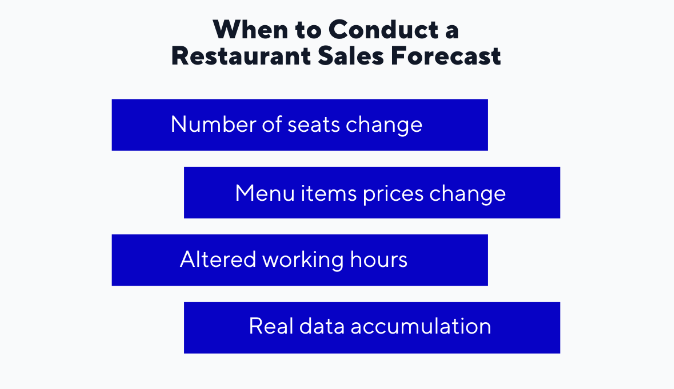
Illustration: Tablein / Data: RestoHub
In other words, you should consider reviewing your sales forecast whenever there’s a significant change in your restaurant’s operations.
This is on top of the sales forecasts you should conduct routinely, as accumulating real data about your restaurant can give you more relevant insights.
But why are sales forecasts so crucial for restaurants?
Why Is Sales Forecasting Important for Restaurants
Sales forecasting is vital to a restaurant's overall success and growth because it facilitates informed decision-making and effective resource allocation.
There are two scenarios in which it can be especially effective in guiding your actions, so let’s take a closer look at them.
The first scenario is when a sales forecast predicts a growth in sales for the coming period.
In this case, restaurant owners and managers can use this information to better prepare for this surge in demand by increasing their inventory orders and modifying the staff schedule to account for the increased workload.
Conversely, suppose a sales forecast indicates a decrease in sales.
As this can result in losses for the restaurant, proactive measures need to be taken to minimize them, such as improving the efficiency of inventory management and even reducing the number of workers.
The following sections will explore three key benefits of regularly conducting sales forecasts, from helping you manage your staff and resources to shaping major business decisions.
Let’s begin with why this approach will help you manage your inventory.
Improving the Restaurant’s Inventory Management
Sales forecasting plays a vital role in streamlining inventory control and ensuring that a restaurant always has the right amount of stock on hand.
By accurately predicting future sales, restaurant owners and managers can make informed decisions about how much inventory to order and when.
This practice helps maintain an optimal balance between having enough stock to meet customer demand and avoiding excess inventory that could lead to wasted food.
Regular and accurate forecasting can optimize your inventory management, which, in turn, can benefit your business in a number of ways.
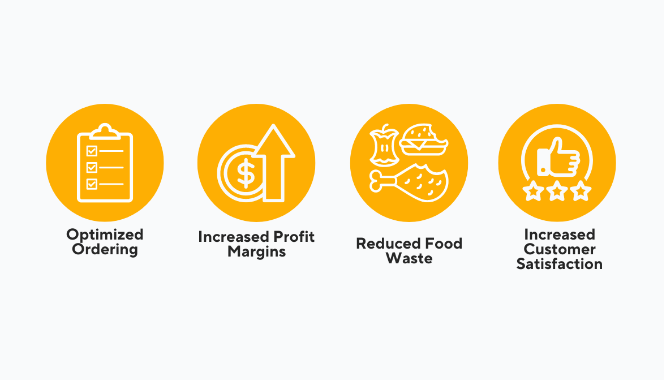
Illustration: Tablein / Data: Sculpture Hospitality
In essence, sales forecasting enables restaurants to optimize their ordering processes, driving up profit margins by reducing unnecessary expenses.
Moreover, keeping track of restaurant inventory helps reduce food waste, an important consideration, as restaurants and other food service institutions are the second major contributor to global waste.

Source: RTS
Finally, by implementing sales forecasting, restaurants can also improve customer satisfaction.
They can predict which menu items are most popular and ensure they are consistently available, preventing disappointment and creating a more enjoyable dining experience for customers.
So, sales forecasting is a valuable tool that can assist you in improving inventory management, optimizing expenses, and ensuring you are equipped to meet the demands of your customers.
Predicting the Restaurant’s Staffing Needs
Another way you can optimize your restaurant’s expenses through sales forecasting is by predicting your staffing needs.
Labor costs often account for a significant portion of a restaurant’s expenses, so it’s essential to manage them properly.
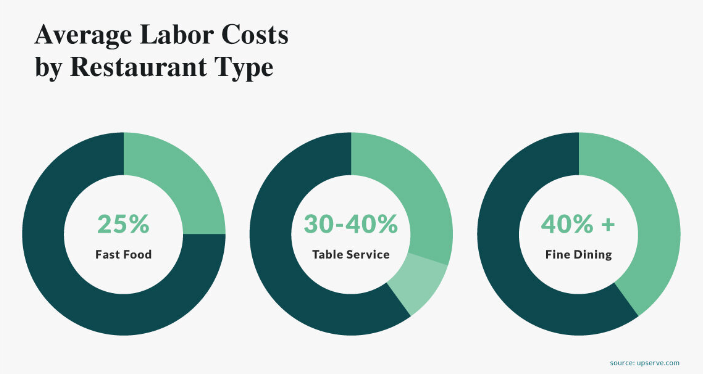
Source: Notch
As you can see from the above image, labor costs can take up, at minimum, a quarter of your expenses, and even up to a third, depending on the establishment you are running.
Sales forecasting is critical in predicting staffing needs by utilizing various pieces of data and trends to anticipate how many employees will be required during specific periods.
This process ensures that the restaurant is adequately staffed without incurring unnecessary labor costs.
In fact, the primary way you can utilize the data from the forecasts is to help prevent understaffing and overstaffing.
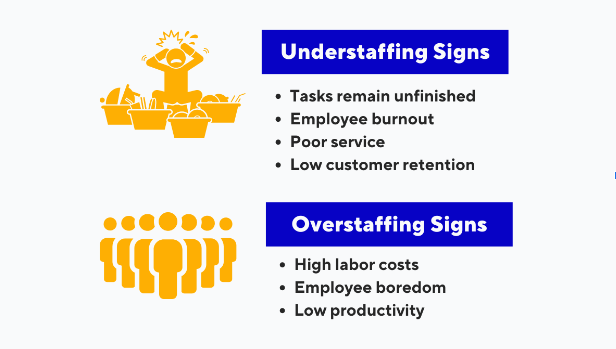
Source: Tablein
Both situations can be bad for your business, but by accurately predicting sales, you can adjust staffing needs appropriately.
For example, if your sales forecast indicates that your restaurant will experience a 20% increase in sales during a holiday weekend, you can plan to have more staff members on hand to handle the influx of customers.
On the other hand, if you anticipate a slower period, you can reduce the number of employees scheduled to work, cutting labor costs without sacrificing the quality of your service.
Overall, fine-tuning your staffing through sales forecasting ensures you maximize your profits while having enough workers to keep your restaurant running smoothly.
Making Future Plans Based on Expected Profit
Sale forecasts can help not only in managing your resources and staffing in the short term but can also play a pivotal role in making plans for the future of your business.
A reliable forecast can go a long way for some major business ideas. A positive or negative estimate about future profit can affect a range of decisions, including the following:
- Adjusting marketing efforts
- Menu changes
- Seasonal promotions preparation
- Special events planning
To illustrate our point, we can use a hypothetical situation.
Let’s say your restaurant has conducted a sales forecast that predicts an increase in sales from August to December due to the upcoming holiday season. You may end up with a graph like the one pictured below.
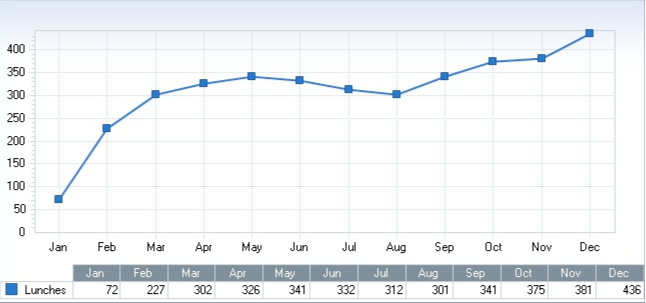
Source: Bplans
Based on this information, you can start by making specific inventory and staffing changes, as discussed in the previous two sections.
Additionally, you can make certain menu changes, such as introducing seasonal items or offering holiday-themed dishes to appeal to customers during this time.
On top of this, you may promote these new menu items and any other seasonal offers by running a social media marketing campaign.
With a reliable sales forecast, you can confidently make these kinds of plans and take proactive measures to maximize profits and ensure the long-term success of your business.
How to Forecast Restaurant Sales for Existing Restaurants
Now that you’ve seen compelling reasons to predict future sales, let’s dive into how you can conduct a forecast.
We’ll start by explaining how to predict sales for an existing restaurant.
The already-established eateries differ from the newly-opened establishments in that they have a wealth of data at their disposal, which can be used to make forecasts more accurate.
In fact, when doing a sales forecast, you can consider the following:
- Past sales
- Recent sale trends
- External factors, such as seasonal changes, competitor actions, and economic conditions
These pieces of data can be used in historical sales forecasting, a practical approach that can only be used for businesses that have been in operation for some time and have accumulated sufficient data.
Say you want to use your restaurant's sales data from the last six months to predict the profit for the upcoming four months.
In that case, you would use the historical trends and patterns in the past data to create a projection that may look like the graph shown below.
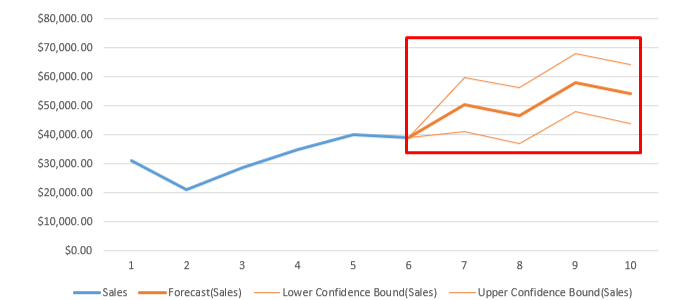
Source: Exceldemy
You don’t need special tools to create these kinds of forecasts, as a simple Excel spreadsheet can be used to analyze your existing data and visualize the results.
The above graph shows the forecast with a thick orange line alongside the upper and lower confidence bounds to account for potential variations.
As you can see, forecasting sales for existing restaurants is primarily a data-driven process that leverages your historical trends to make informed predictions and set the stage for your future success.
How to Forecast Restaurant Sales for New Restaurants
Forecasting the sales of new restaurants requires a slightly different approach than doing so for already-established eateries.
Since new restaurants lack enough data to make historical forecasts, the forecasting process involves more intuition and estimation. For these situations, intuitive forecasting is one of the best options.
Despite being called intuitive forecasting, this method is far from being unsupported by data.
On the contrary, if you plan on conducting a forecast in this manner, you should use several data points, such as the following:
- The number of days you plan to be open each week
- The average number of guests you'll serve weekly
- The average anticipated spending per guest
As most of this information is based on assumptions, it’s best to consult with other restaurant owners and use their data and experiences to create your sales forecasting model.
You can also try and use a simple formula.
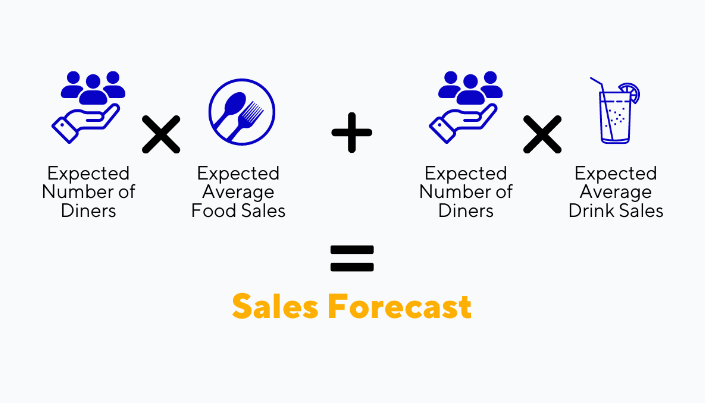
Illustration: Tablein / Data: GloriaFood
The sales forecast is calculated by multiplying the number of diners you expect to visit in a given period by the average food sales and adding that to the number of diners multiplied by the average drinks sales.
This data lets you make informed menu pricing choices, determine your staffing requirements, and helps you adjust your overall business strategy to ensure you are well-prepared.
New restaurants face unique challenges in forecasting, but with the right approach, accurate sales forecasts can still be achieved.
How Reservation Software Helps With Sales Forecasting
A sales forecast doesn’t have to be done solely by crunching numbers by hand.
In fact, many software solutions can help provide the necessary data to streamline this process, making forecasting both more accurate and efficient.
Your POS system, for instance, can provide crucial sales data, such as total revenue, the average transaction value, and the number of customers served within specific periods.
This information can be integrated into your sales predictions and used to analyze trends and customer purchasing behavior.
And, by adding the data from a feature-rich restaurant reservation app like Tablein to the mix, you can further enhance the accuracy of your sales predictions.
Tablein is a comprehensive reservation management system that helps restaurants manage bookings, reservations, and customer relations.
Besides being a valuable way for your guests to book tables, Tablein provides detailed reports that can give you a wealth of information for your restaurant revenue forecasts.
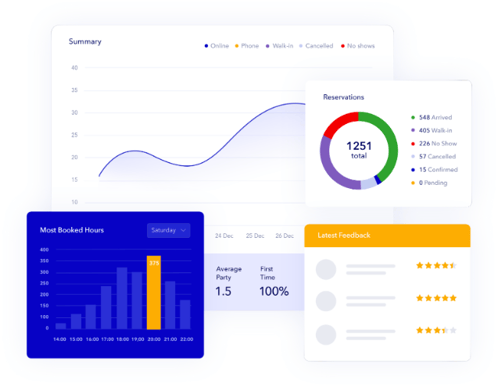
Source: Tablein
This software solution provides several practical data metrics, such as the following:
- Most-booked hours
- Country list
- Loyal guests
- Recent reservations
For example, the data concerning the most-booked hours can help you quickly identify peak dining times, with statistics being conveyed in intuitive and detailed graphs, such as the one pictured below.
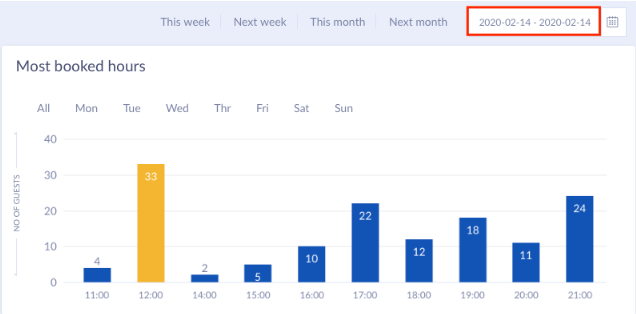
Source: Tablein
You have the flexibility to select the time for which you want the data, such as a specific week, a month, or even the entire Tablein lifetime, allowing you to view more general trends across longer time spans and get more detailed findings.
Leveraging software solutions such as your POS or a reservation system like Tablein enables you to optimize your sales forecast, accurately anticipate future trends, and, ultimately, increase your profits.
Conclusion
Throughout this comprehensive guide, we've explored the importance of restaurant sales forecasting and how it can be a game-changer for your business.
By understanding this concept and implementing the strategies we have covered, you will be able to make more informed decisions about the future of your establishment and optimize your staffing and resource management practices.
Doing so can ultimately help boost your restaurant's profitability and bottom line in the long run.
As you apply the gained knowledge and strategies to your restaurant's unique circumstances, you'll find that sales forecasting becomes an indispensable tool for propelling your business toward sustainable growth and success.
So, it's time to implement your newfound knowledge and witness your restaurant thrive like never before.
Get a 30-day Exclusive Trial
As a Tablein blog reader, you’re eligible for an exclusive 30-day free trial to experience our simple reservation solution for your restaurant.
Enter your business email, and we’ll send you all the steps needed to create your account.
Share this
You may also like
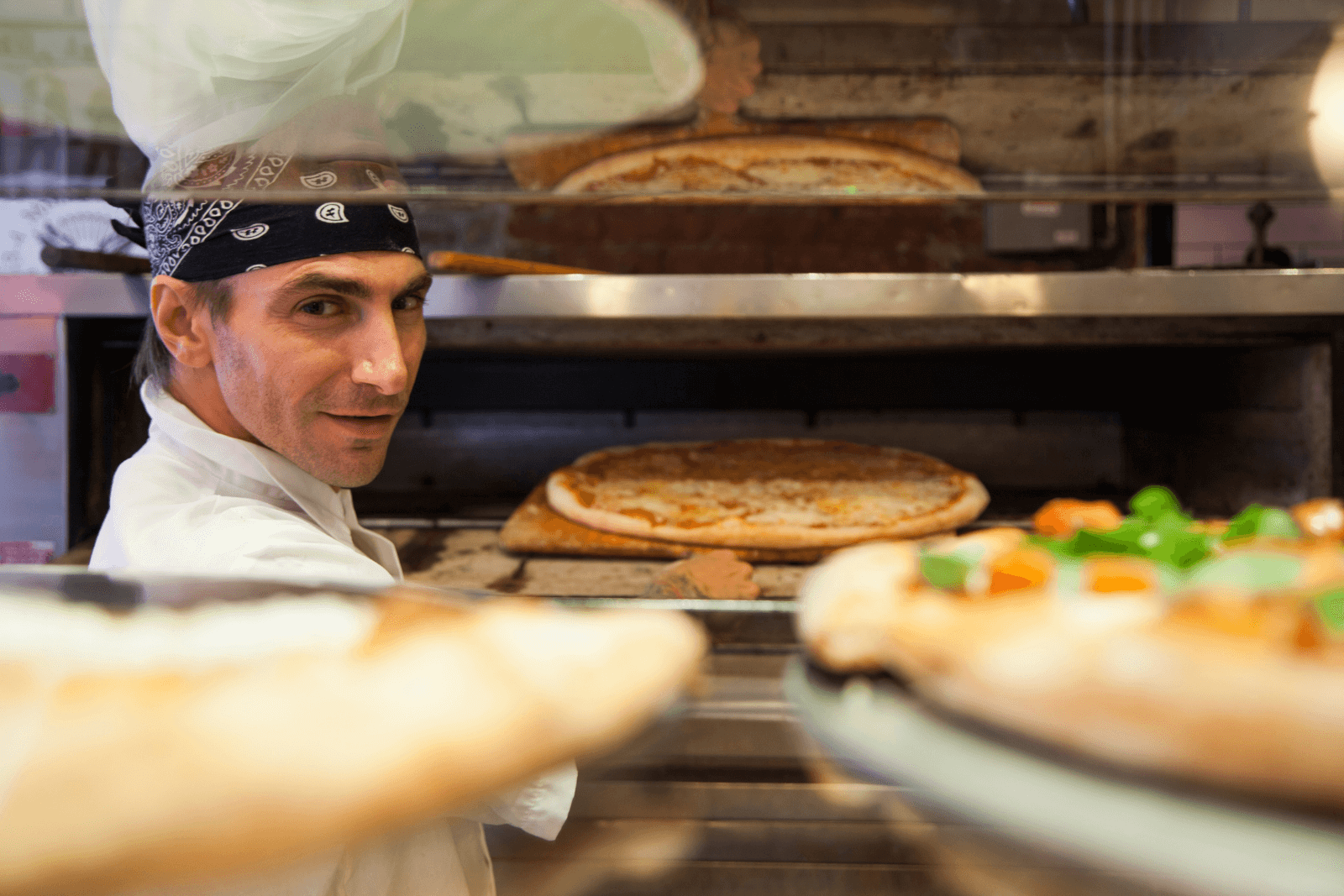
5 Trends Transforming Restaurant Operations

Top 7 Features a Restaurant Reservation Software Needs to Have
